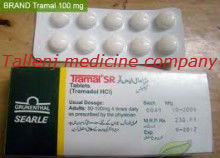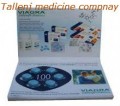 Loading... Please wait...
Loading... Please wait...- Home
- Pain Relievers
- Tramadoll 100mg from Searle x 1 Blister
Product Description
Type a description for this product here...
ramadol is used similarly to codeine, to treat moderate to moderately severe pain and most types of neuralgia, including trigeminal neuralgia.[10] Tramadol is somewhat pharmacologically similar to levorphanolSNRI activity (other such opioids to do the same are dextropropoxyphene (Darvon) & M1-like molecule tapentadol[11] because of its action on the noradrenergic and serotonergic systems, such as its "atypical" opioid activity.[12] However, health professionals have not endorsed its use for these disorders,[13][14] claiming it may be used as a unique treatment (only when other treatments failed), and must be used under the control of a psychiatrist.[15][16] (albeit with much lower μ-agonism), as both opioids are also NMDA-antagonists which also have (Nucynta, a new synthetic atypical opioid made to mimic the agonistic properties of tramadol's metabolite, M1(O-Desmethyltramadol). It has been suggested that tramadol could be effective for alleviating symptoms of depression, anxiety, and phobias
In May 2009, the United States Food and Drug Administration issued a Warning Letter to Johnson & Johnson, alleging that a promotional website commissioned by the manufacturer had "overstated the efficacy" of the drug, and "minimized the serious risks".[17] The company which produced it, the German pharmaceutical company Grünenthal GmbH, were the ones alleged t
"minimizing" the addictive nature and proposed efficacy of the drug, although it showed little abuse liability in preliminary tests. The 2010 Physicians Desk Reference contains several warnings from the manufacturer, which were not present in prior years. The warnings include more compelling language regarding the addictive potential of tramadol, the possibility of difficulty breathing while on the medication, a new list of more serious side effects, and a notice that tramadol is not to be used in place of opiate medications for addicts. Tramadol is also not to be used in efforts to wean addict patients from opiate drugs, nor to be used to manage long-term opiate addiction.
Availability and Usage:
Tramadol is usually marketed as the hydrochloride salt (tramadol hydrochloride); the tartrate is seen on rare occasions, and rarely (in the US at least) tramadol is available for both injection (intravenous and/or intramuscular) and oral administration. The most well known dosing unit is the 50 mg generic tablet made by several manufacturers. It is also commonly available in conjunction with APAP (Paracetamol, Acetaminophen) as Ultracet, in the form of a smaller dose of 37.5 mg tramadol and 325 mg of APAP. The solutions suitable for injection are used in patient-controlled analgesia pumps under some circumstances, either as the sole agent or along with another agent such as morphine.
Tramadol comes in many forms, including:
o be g

















